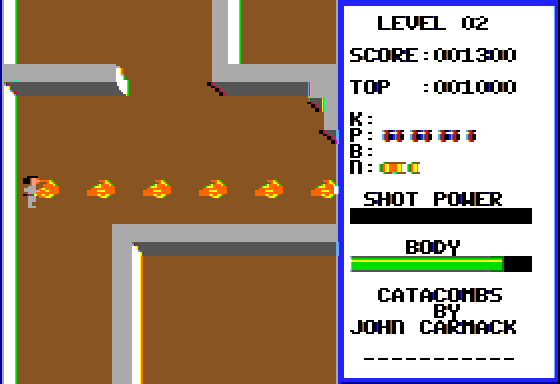Retro Replay Review
Gameplay
At its core, Catacomb delivers a straightforward, arcade-style dungeon crawl that’s immediately accessible. You step into the shoes of a lone, projectile-firing hero who can switch between three distinct shot types—“little,” “big,” and the aptly named “Really Big”—to tackle waves of monsters. The controls are crisp, and the addition of a dedicated “strafe” key feels remarkably ahead of its time, giving you room to sidestep oncoming threats while peppering foes with magic bolts.
(HEY YOU!! We hope you enjoy! We try not to run ads. So basically, this is a very expensive hobby running this site. Please consider joining us for updates, forums, and more. Network w/ us to make some cash or friends while retro gaming, and you can win some free retro games for posting. Okay, carry on 👍)
The level design is built around twisty, monster-filled mazes that alternate between claustrophobic corridors and small chambers teeming with enemies. In the DOS version you’ll face 10 increasingly challenging stages; the Apple II and Apple IIgs ports expand your dungeon count to 15 levels, while fans of the series can dive into another 30 in its look-alike sequel, The Catacomb. Throughout, you’re encouraged to explore every nook, blast suspicious walls to reveal secret passages, and rack up points by dispatching monsters in succession without taking hits.
Though it hews close to the blueprint popularized by Gauntlet, Catacomb carves out its own identity through its emphasis on magic projectiles and hidden doorways. You’ll quickly learn to conserve your ammo type, choosing “little” shots for weaker grunts and saving your “Really Big” blasts for tougher adversaries or when you need to clear a path in a tight spot. The high-score chase and small bonuses for clearing rooms without damage add enough incentive to keep you replaying the same levels until you perfect your route.
Graphics
Visually, Catacomb is firmly planted in the late-’80s era of DOS and Apple II graphics. The top-down view employs simple tile-based walls and flat-shaded floors, delivering just enough clarity to distinguish monsters, treasure chests, and breakable walls. On a CGA or EGA system you’ll notice the limited color palette—often two or three hues per screen—but this restriction is handled gracefully, making each corridor and chamber readable even in the heat of combat.
The monster sprites are small but expressive: skeletal warriors, green slimes, and ethereal wraiths each have distinctive silhouettes and movement patterns. When you blast away a section of wall to reveal a hidden passage, the brief animation of crumbling bricks adds a satisfying touch. On Apple II hardware, the palette shifts slightly, and you might experience some screen flicker during intense encounters, but the overall presentation remains functional and serviceable.
While today’s standards would dismiss Catacomb’s visuals as rudimentary, it’s important to view them in historical context. These graphics laid the technical groundwork for the series’ leap into three dimensions. The “secret-passage-by-shooting” conceit and the sprite handling routines were progenitors of the engine that eventually powered Catacomb 3-D, which in turn inspired John Carmack’s innovations in Wolfenstein 3D and DOOM.
Story
If you’re chasing a deep narrative, Catacomb might leave you wanting. The game offers no elaborate backstory, character arcs, or cutscenes—just the simple premise of a magic-wielding hero venturing through a dangerous labyrinth. This minimalism was par for the course in 1989, when gameplay took precedence over plot, and Catacomb embraces that tradition wholeheartedly.
Any lore you might glean comes from external manuals or contemporary magazine write-ups, not from in-game dialogue or text. You won’t find journals, NPC interactions, or branching story paths—your motivation is purely mechanical: survive, score points, and unlock secrets. In that sense, the narrative exists only in your mind’s eye, fueled by the relentless advance of monsters and the thrill of uncovering hidden rooms.
However, the game’s bare-bones approach to storytelling does serve a purpose. It keeps the focus squarely on maze navigation, combat tactics, and mastery of the projectile system. For many players of the era, that was precisely the appeal: no hand-holding, no plot detours—just you, your spells, and a hungry horde of dungeon denizens.
Overall Experience
Catacomb stands as a compelling relic of early dungeon-crawling action games. While it lacks the refinement and narrative depth of later titles, its straightforward design makes for a pick-up-and-play session that still holds nostalgic charm. The tight controls, combined with the incremental challenge of secret passages and escalating monster variety, offer bite-sized thrills that can quickly suck you back in for “just one more run.”
From a modern perspective, Catacomb is best appreciated for its historical significance. It introduced gameplay mechanics—like shooting open secret doors and strafing—that would become staples of first-person action in the years to follow. Fans of retro gaming and those curious about the roots of icons like Carmack’s DOOM will find plenty to love here, even if the high-score chase feels quaint compared to contemporary standards.
Ultimately, Catacomb delivers a concise, action-oriented romp that owes more to pure arcade sensibilities than to rich storytelling or groundbreaking visuals. It’s a fascinating snapshot of where the genre was headed and a worthy addition to any retro gaming collection. If you appreciate the lineage of dungeon crawlers and want to witness one of the stepping stones toward 3-D shooters, Catacomb remains a rewarding experience.
 Retro Replay Retro Replay gaming reviews, news, emulation, geek stuff and more!
Retro Replay Retro Replay gaming reviews, news, emulation, geek stuff and more!








Reviews
There are no reviews yet.